Foundations of Human Nutrition (NMDF121) Case Study Analysis
VerifiedAdded on 2023/04/08
|28
|5714
|54
Case Study
AI Summary
This report analyzes the case of Douglas, focusing on his nutritional imbalances and their impact on his health. The report begins with a case overview, detailing Douglas's presenting complaints of osteoporosis, hypertension, and dyslipidemia. A nutritional analysis, based on Food Works 9 Software, reveals deficiencies in calcium, magnesium, zinc, and fiber, along with excesses in B complex vitamins, sodium, and fats. The report then establishes both short-term goals, such as improving fiber intake and reducing sugar consumption, and long-term goals, like weight loss and reducing the risk of cardiovascular diseases. Therapeutic recommendations include dietary adjustments, such as reducing sodium and sugar intake, increasing vitamin C and D consumption, and incorporating a balanced diet. Lifestyle changes, like resistance training and reducing alcohol consumption, are also advised to improve overall health outcomes and prevent chronic diseases. The report concludes with a summary of the key recommendations for Douglas's health improvement.
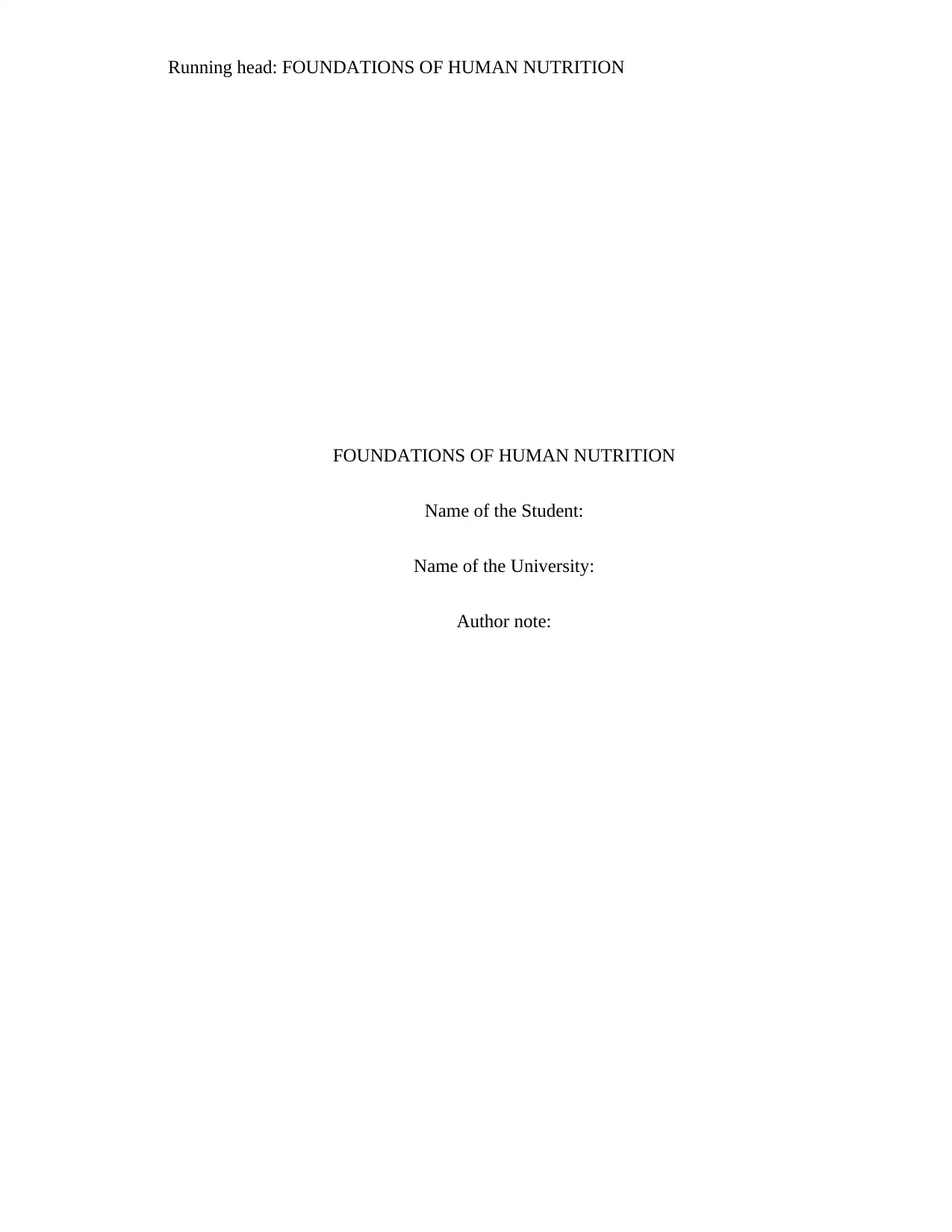
Running head: FOUNDATIONS OF HUMAN NUTRITION
FOUNDATIONS OF HUMAN NUTRITION
Name of the Student:
Name of the University:
Author note:
FOUNDATIONS OF HUMAN NUTRITION
Name of the Student:
Name of the University:
Author note:
Paraphrase This Document
Need a fresh take? Get an instant paraphrase of this document with our AI Paraphraser
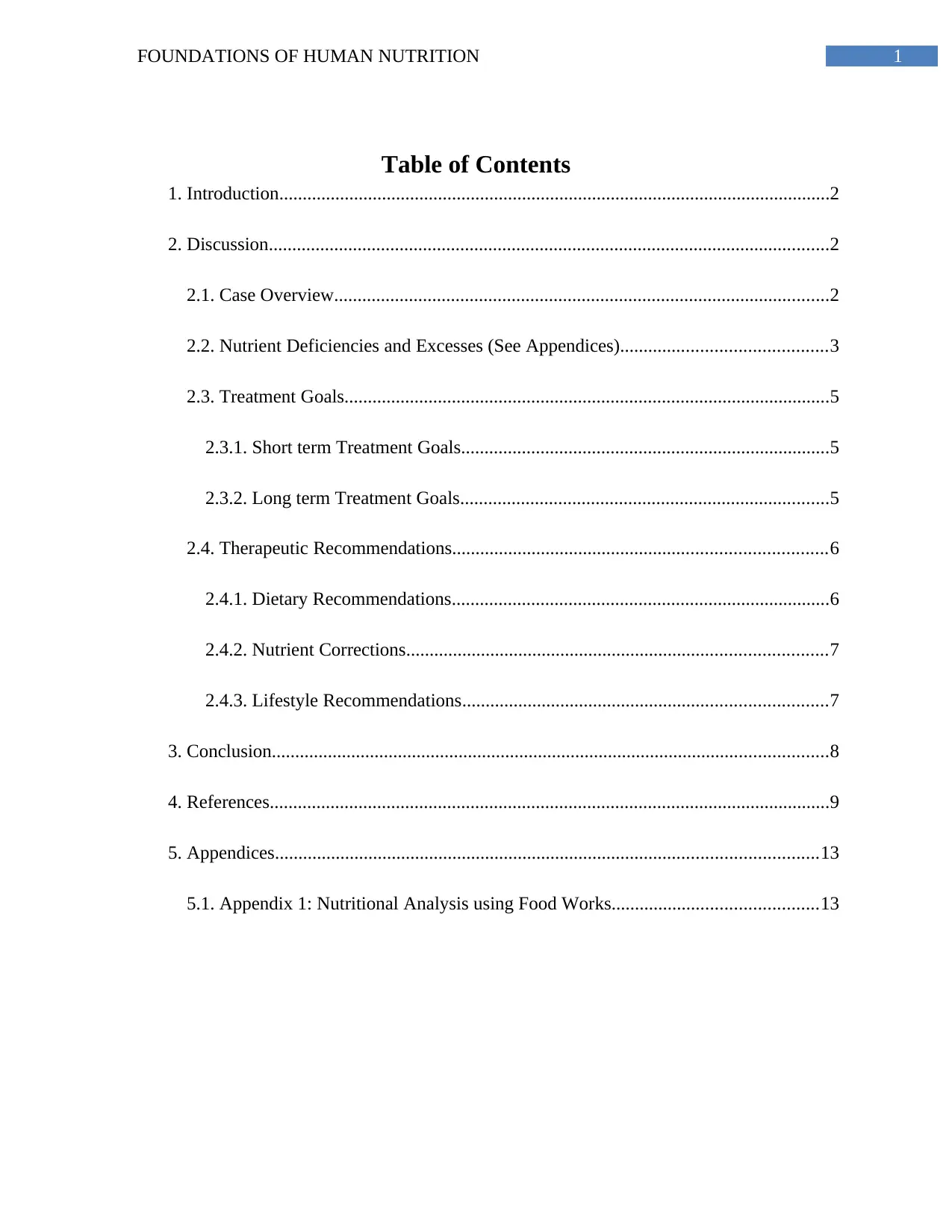
1FOUNDATIONS OF HUMAN NUTRITION
Table of Contents
1. Introduction......................................................................................................................2
2. Discussion........................................................................................................................2
2.1. Case Overview..........................................................................................................2
2.2. Nutrient Deficiencies and Excesses (See Appendices)............................................3
2.3. Treatment Goals........................................................................................................5
2.3.1. Short term Treatment Goals...............................................................................5
2.3.2. Long term Treatment Goals...............................................................................5
2.4. Therapeutic Recommendations................................................................................6
2.4.1. Dietary Recommendations.................................................................................6
2.4.2. Nutrient Corrections..........................................................................................7
2.4.3. Lifestyle Recommendations..............................................................................7
3. Conclusion.......................................................................................................................8
4. References........................................................................................................................9
5. Appendices....................................................................................................................13
5.1. Appendix 1: Nutritional Analysis using Food Works............................................13
Table of Contents
1. Introduction......................................................................................................................2
2. Discussion........................................................................................................................2
2.1. Case Overview..........................................................................................................2
2.2. Nutrient Deficiencies and Excesses (See Appendices)............................................3
2.3. Treatment Goals........................................................................................................5
2.3.1. Short term Treatment Goals...............................................................................5
2.3.2. Long term Treatment Goals...............................................................................5
2.4. Therapeutic Recommendations................................................................................6
2.4.1. Dietary Recommendations.................................................................................6
2.4.2. Nutrient Corrections..........................................................................................7
2.4.3. Lifestyle Recommendations..............................................................................7
3. Conclusion.......................................................................................................................8
4. References........................................................................................................................9
5. Appendices....................................................................................................................13
5.1. Appendix 1: Nutritional Analysis using Food Works............................................13
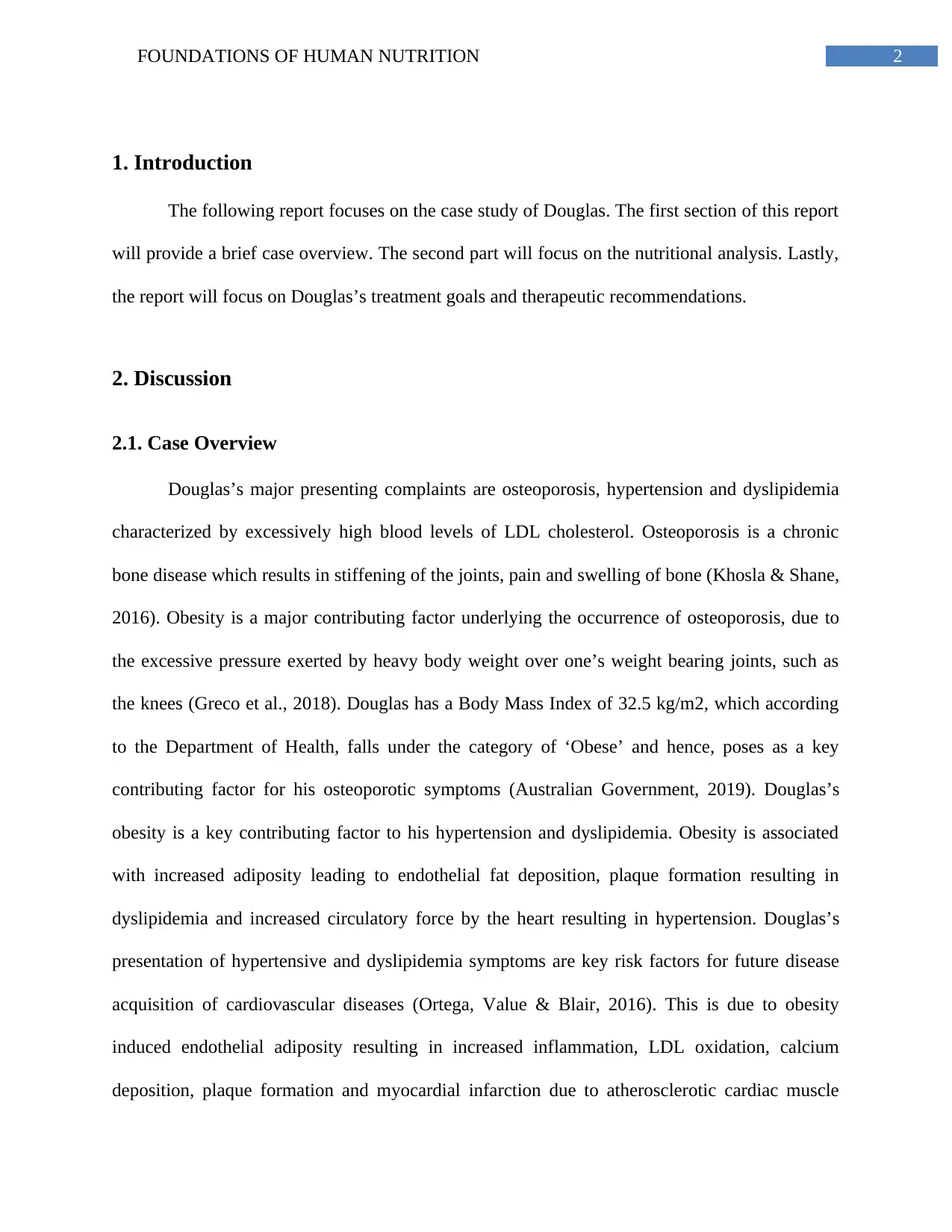
2FOUNDATIONS OF HUMAN NUTRITION
1. Introduction
The following report focuses on the case study of Douglas. The first section of this report
will provide a brief case overview. The second part will focus on the nutritional analysis. Lastly,
the report will focus on Douglas’s treatment goals and therapeutic recommendations.
2. Discussion
2.1. Case Overview
Douglas’s major presenting complaints are osteoporosis, hypertension and dyslipidemia
characterized by excessively high blood levels of LDL cholesterol. Osteoporosis is a chronic
bone disease which results in stiffening of the joints, pain and swelling of bone (Khosla & Shane,
2016). Obesity is a major contributing factor underlying the occurrence of osteoporosis, due to
the excessive pressure exerted by heavy body weight over one’s weight bearing joints, such as
the knees (Greco et al., 2018). Douglas has a Body Mass Index of 32.5 kg/m2, which according
to the Department of Health, falls under the category of ‘Obese’ and hence, poses as a key
contributing factor for his osteoporotic symptoms (Australian Government, 2019). Douglas’s
obesity is a key contributing factor to his hypertension and dyslipidemia. Obesity is associated
with increased adiposity leading to endothelial fat deposition, plaque formation resulting in
dyslipidemia and increased circulatory force by the heart resulting in hypertension. Douglas’s
presentation of hypertensive and dyslipidemia symptoms are key risk factors for future disease
acquisition of cardiovascular diseases (Ortega, Value & Blair, 2016). This is due to obesity
induced endothelial adiposity resulting in increased inflammation, LDL oxidation, calcium
deposition, plaque formation and myocardial infarction due to atherosclerotic cardiac muscle
1. Introduction
The following report focuses on the case study of Douglas. The first section of this report
will provide a brief case overview. The second part will focus on the nutritional analysis. Lastly,
the report will focus on Douglas’s treatment goals and therapeutic recommendations.
2. Discussion
2.1. Case Overview
Douglas’s major presenting complaints are osteoporosis, hypertension and dyslipidemia
characterized by excessively high blood levels of LDL cholesterol. Osteoporosis is a chronic
bone disease which results in stiffening of the joints, pain and swelling of bone (Khosla & Shane,
2016). Obesity is a major contributing factor underlying the occurrence of osteoporosis, due to
the excessive pressure exerted by heavy body weight over one’s weight bearing joints, such as
the knees (Greco et al., 2018). Douglas has a Body Mass Index of 32.5 kg/m2, which according
to the Department of Health, falls under the category of ‘Obese’ and hence, poses as a key
contributing factor for his osteoporotic symptoms (Australian Government, 2019). Douglas’s
obesity is a key contributing factor to his hypertension and dyslipidemia. Obesity is associated
with increased adiposity leading to endothelial fat deposition, plaque formation resulting in
dyslipidemia and increased circulatory force by the heart resulting in hypertension. Douglas’s
presentation of hypertensive and dyslipidemia symptoms are key risk factors for future disease
acquisition of cardiovascular diseases (Ortega, Value & Blair, 2016). This is due to obesity
induced endothelial adiposity resulting in increased inflammation, LDL oxidation, calcium
deposition, plaque formation and myocardial infarction due to atherosclerotic cardiac muscle
⊘ This is a preview!⊘
Do you want full access?
Subscribe today to unlock all pages.

Trusted by 1+ million students worldwide
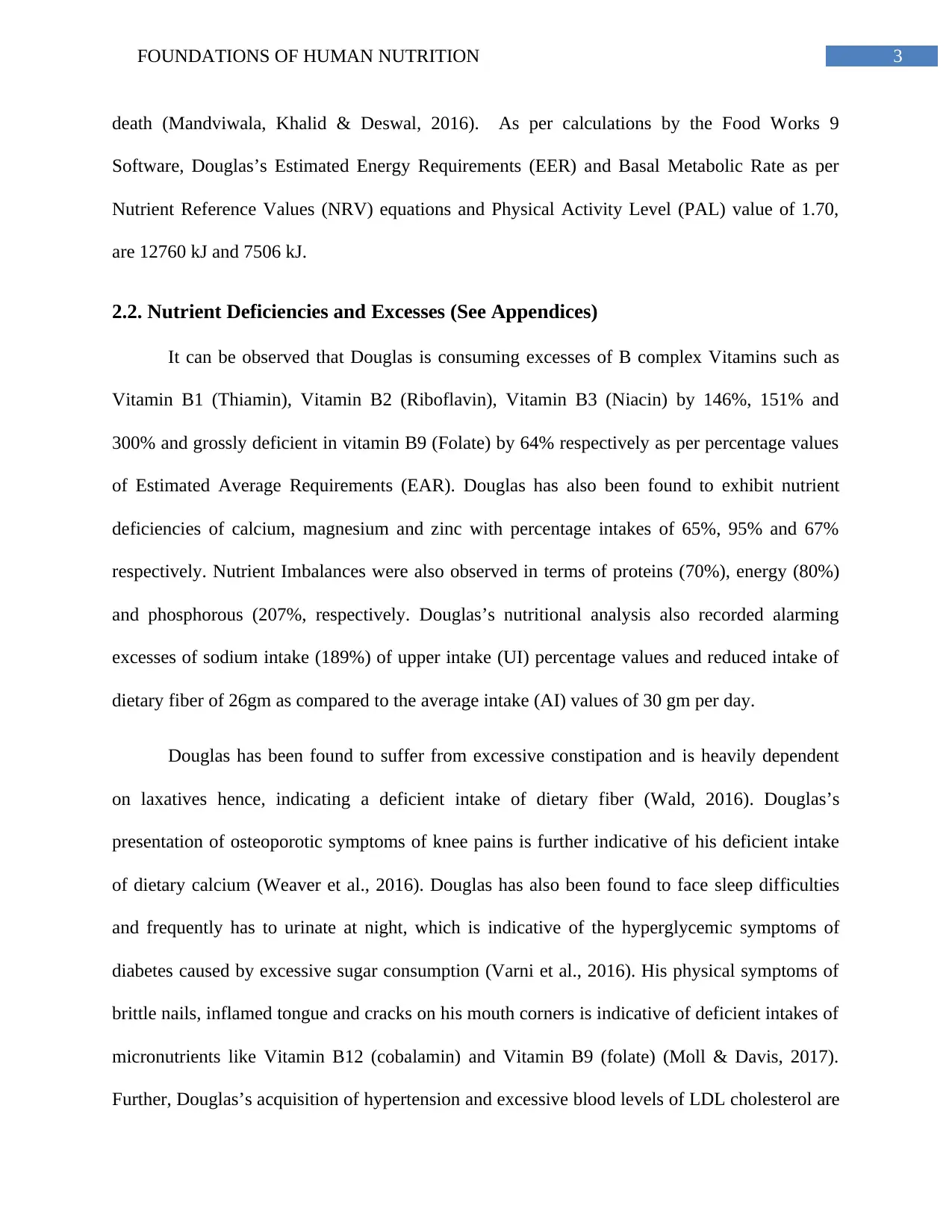
3FOUNDATIONS OF HUMAN NUTRITION
death (Mandviwala, Khalid & Deswal, 2016). As per calculations by the Food Works 9
Software, Douglas’s Estimated Energy Requirements (EER) and Basal Metabolic Rate as per
Nutrient Reference Values (NRV) equations and Physical Activity Level (PAL) value of 1.70,
are 12760 kJ and 7506 kJ.
2.2. Nutrient Deficiencies and Excesses (See Appendices)
It can be observed that Douglas is consuming excesses of B complex Vitamins such as
Vitamin B1 (Thiamin), Vitamin B2 (Riboflavin), Vitamin B3 (Niacin) by 146%, 151% and
300% and grossly deficient in vitamin B9 (Folate) by 64% respectively as per percentage values
of Estimated Average Requirements (EAR). Douglas has also been found to exhibit nutrient
deficiencies of calcium, magnesium and zinc with percentage intakes of 65%, 95% and 67%
respectively. Nutrient Imbalances were also observed in terms of proteins (70%), energy (80%)
and phosphorous (207%, respectively. Douglas’s nutritional analysis also recorded alarming
excesses of sodium intake (189%) of upper intake (UI) percentage values and reduced intake of
dietary fiber of 26gm as compared to the average intake (AI) values of 30 gm per day.
Douglas has been found to suffer from excessive constipation and is heavily dependent
on laxatives hence, indicating a deficient intake of dietary fiber (Wald, 2016). Douglas’s
presentation of osteoporotic symptoms of knee pains is further indicative of his deficient intake
of dietary calcium (Weaver et al., 2016). Douglas has also been found to face sleep difficulties
and frequently has to urinate at night, which is indicative of the hyperglycemic symptoms of
diabetes caused by excessive sugar consumption (Varni et al., 2016). His physical symptoms of
brittle nails, inflamed tongue and cracks on his mouth corners is indicative of deficient intakes of
micronutrients like Vitamin B12 (cobalamin) and Vitamin B9 (folate) (Moll & Davis, 2017).
Further, Douglas’s acquisition of hypertension and excessive blood levels of LDL cholesterol are
death (Mandviwala, Khalid & Deswal, 2016). As per calculations by the Food Works 9
Software, Douglas’s Estimated Energy Requirements (EER) and Basal Metabolic Rate as per
Nutrient Reference Values (NRV) equations and Physical Activity Level (PAL) value of 1.70,
are 12760 kJ and 7506 kJ.
2.2. Nutrient Deficiencies and Excesses (See Appendices)
It can be observed that Douglas is consuming excesses of B complex Vitamins such as
Vitamin B1 (Thiamin), Vitamin B2 (Riboflavin), Vitamin B3 (Niacin) by 146%, 151% and
300% and grossly deficient in vitamin B9 (Folate) by 64% respectively as per percentage values
of Estimated Average Requirements (EAR). Douglas has also been found to exhibit nutrient
deficiencies of calcium, magnesium and zinc with percentage intakes of 65%, 95% and 67%
respectively. Nutrient Imbalances were also observed in terms of proteins (70%), energy (80%)
and phosphorous (207%, respectively. Douglas’s nutritional analysis also recorded alarming
excesses of sodium intake (189%) of upper intake (UI) percentage values and reduced intake of
dietary fiber of 26gm as compared to the average intake (AI) values of 30 gm per day.
Douglas has been found to suffer from excessive constipation and is heavily dependent
on laxatives hence, indicating a deficient intake of dietary fiber (Wald, 2016). Douglas’s
presentation of osteoporotic symptoms of knee pains is further indicative of his deficient intake
of dietary calcium (Weaver et al., 2016). Douglas has also been found to face sleep difficulties
and frequently has to urinate at night, which is indicative of the hyperglycemic symptoms of
diabetes caused by excessive sugar consumption (Varni et al., 2016). His physical symptoms of
brittle nails, inflamed tongue and cracks on his mouth corners is indicative of deficient intakes of
micronutrients like Vitamin B12 (cobalamin) and Vitamin B9 (folate) (Moll & Davis, 2017).
Further, Douglas’s acquisition of hypertension and excessive blood levels of LDL cholesterol are
Paraphrase This Document
Need a fresh take? Get an instant paraphrase of this document with our AI Paraphraser
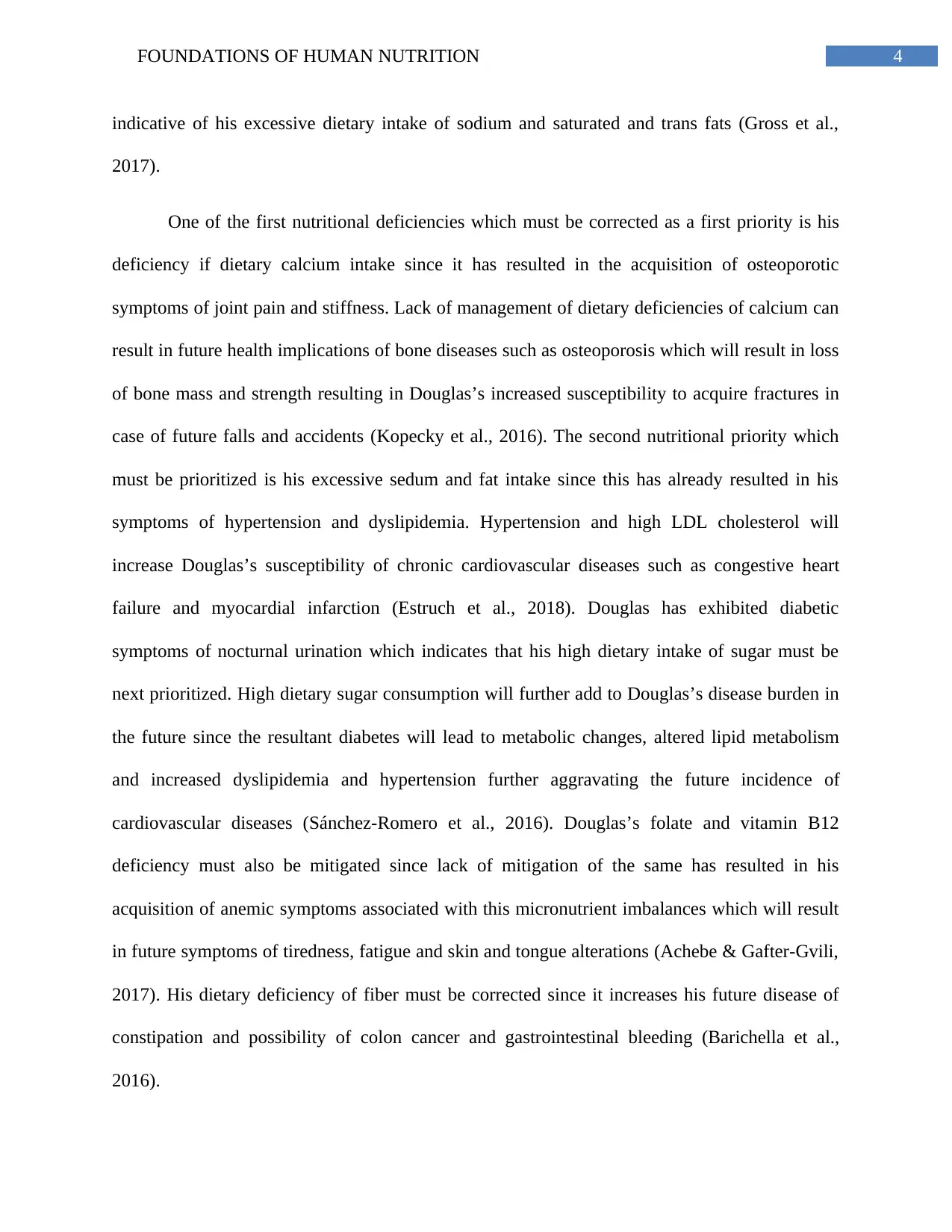
4FOUNDATIONS OF HUMAN NUTRITION
indicative of his excessive dietary intake of sodium and saturated and trans fats (Gross et al.,
2017).
One of the first nutritional deficiencies which must be corrected as a first priority is his
deficiency if dietary calcium intake since it has resulted in the acquisition of osteoporotic
symptoms of joint pain and stiffness. Lack of management of dietary deficiencies of calcium can
result in future health implications of bone diseases such as osteoporosis which will result in loss
of bone mass and strength resulting in Douglas’s increased susceptibility to acquire fractures in
case of future falls and accidents (Kopecky et al., 2016). The second nutritional priority which
must be prioritized is his excessive sedum and fat intake since this has already resulted in his
symptoms of hypertension and dyslipidemia. Hypertension and high LDL cholesterol will
increase Douglas’s susceptibility of chronic cardiovascular diseases such as congestive heart
failure and myocardial infarction (Estruch et al., 2018). Douglas has exhibited diabetic
symptoms of nocturnal urination which indicates that his high dietary intake of sugar must be
next prioritized. High dietary sugar consumption will further add to Douglas’s disease burden in
the future since the resultant diabetes will lead to metabolic changes, altered lipid metabolism
and increased dyslipidemia and hypertension further aggravating the future incidence of
cardiovascular diseases (Sánchez-Romero et al., 2016). Douglas’s folate and vitamin B12
deficiency must also be mitigated since lack of mitigation of the same has resulted in his
acquisition of anemic symptoms associated with this micronutrient imbalances which will result
in future symptoms of tiredness, fatigue and skin and tongue alterations (Achebe & Gafter-Gvili,
2017). His dietary deficiency of fiber must be corrected since it increases his future disease of
constipation and possibility of colon cancer and gastrointestinal bleeding (Barichella et al.,
2016).
indicative of his excessive dietary intake of sodium and saturated and trans fats (Gross et al.,
2017).
One of the first nutritional deficiencies which must be corrected as a first priority is his
deficiency if dietary calcium intake since it has resulted in the acquisition of osteoporotic
symptoms of joint pain and stiffness. Lack of management of dietary deficiencies of calcium can
result in future health implications of bone diseases such as osteoporosis which will result in loss
of bone mass and strength resulting in Douglas’s increased susceptibility to acquire fractures in
case of future falls and accidents (Kopecky et al., 2016). The second nutritional priority which
must be prioritized is his excessive sedum and fat intake since this has already resulted in his
symptoms of hypertension and dyslipidemia. Hypertension and high LDL cholesterol will
increase Douglas’s susceptibility of chronic cardiovascular diseases such as congestive heart
failure and myocardial infarction (Estruch et al., 2018). Douglas has exhibited diabetic
symptoms of nocturnal urination which indicates that his high dietary intake of sugar must be
next prioritized. High dietary sugar consumption will further add to Douglas’s disease burden in
the future since the resultant diabetes will lead to metabolic changes, altered lipid metabolism
and increased dyslipidemia and hypertension further aggravating the future incidence of
cardiovascular diseases (Sánchez-Romero et al., 2016). Douglas’s folate and vitamin B12
deficiency must also be mitigated since lack of mitigation of the same has resulted in his
acquisition of anemic symptoms associated with this micronutrient imbalances which will result
in future symptoms of tiredness, fatigue and skin and tongue alterations (Achebe & Gafter-Gvili,
2017). His dietary deficiency of fiber must be corrected since it increases his future disease of
constipation and possibility of colon cancer and gastrointestinal bleeding (Barichella et al.,
2016).
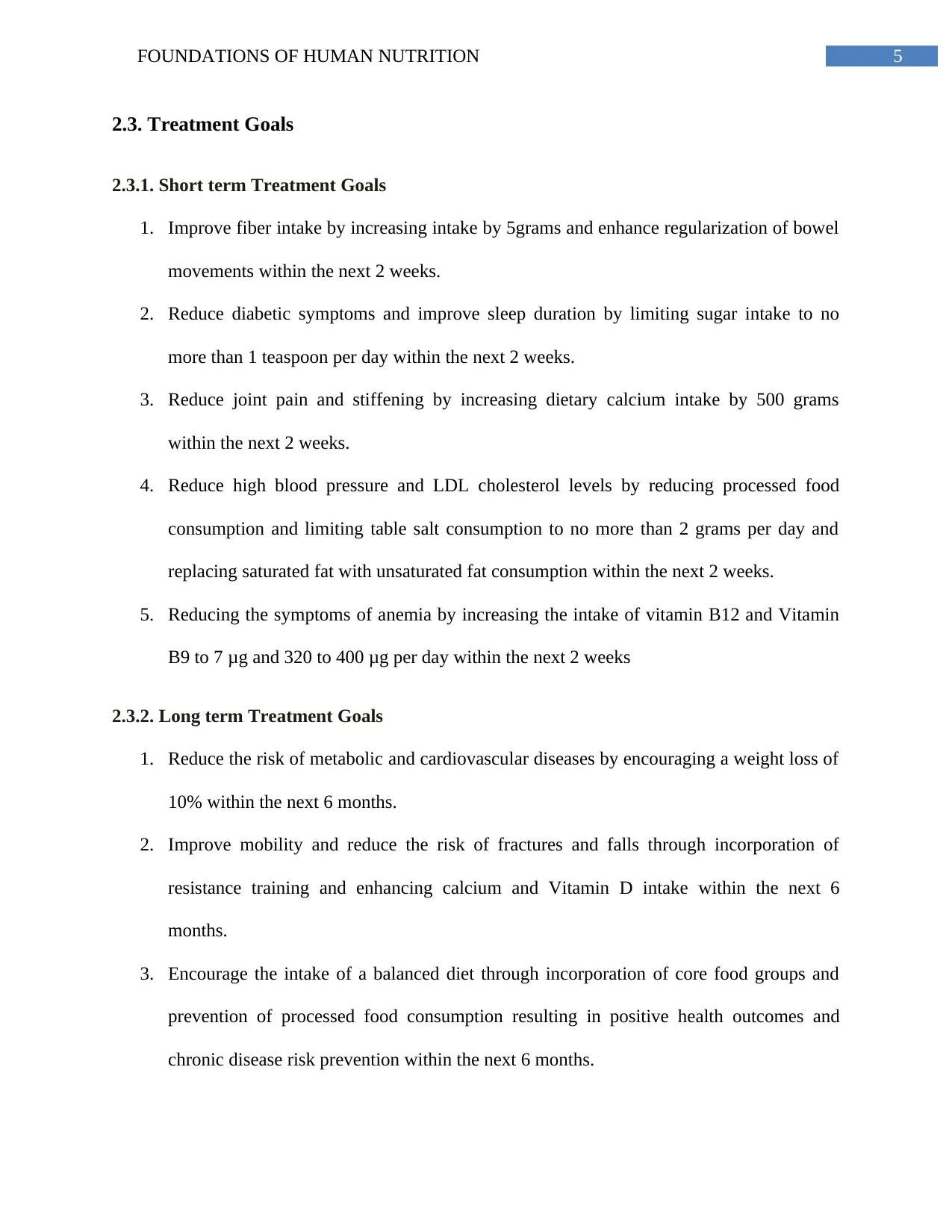
5FOUNDATIONS OF HUMAN NUTRITION
2.3. Treatment Goals
2.3.1. Short term Treatment Goals
1. Improve fiber intake by increasing intake by 5grams and enhance regularization of bowel
movements within the next 2 weeks.
2. Reduce diabetic symptoms and improve sleep duration by limiting sugar intake to no
more than 1 teaspoon per day within the next 2 weeks.
3. Reduce joint pain and stiffening by increasing dietary calcium intake by 500 grams
within the next 2 weeks.
4. Reduce high blood pressure and LDL cholesterol levels by reducing processed food
consumption and limiting table salt consumption to no more than 2 grams per day and
replacing saturated fat with unsaturated fat consumption within the next 2 weeks.
5. Reducing the symptoms of anemia by increasing the intake of vitamin B12 and Vitamin
B9 to 7 μg and 320 to 400 μg per day within the next 2 weeks
2.3.2. Long term Treatment Goals
1. Reduce the risk of metabolic and cardiovascular diseases by encouraging a weight loss of
10% within the next 6 months.
2. Improve mobility and reduce the risk of fractures and falls through incorporation of
resistance training and enhancing calcium and Vitamin D intake within the next 6
months.
3. Encourage the intake of a balanced diet through incorporation of core food groups and
prevention of processed food consumption resulting in positive health outcomes and
chronic disease risk prevention within the next 6 months.
2.3. Treatment Goals
2.3.1. Short term Treatment Goals
1. Improve fiber intake by increasing intake by 5grams and enhance regularization of bowel
movements within the next 2 weeks.
2. Reduce diabetic symptoms and improve sleep duration by limiting sugar intake to no
more than 1 teaspoon per day within the next 2 weeks.
3. Reduce joint pain and stiffening by increasing dietary calcium intake by 500 grams
within the next 2 weeks.
4. Reduce high blood pressure and LDL cholesterol levels by reducing processed food
consumption and limiting table salt consumption to no more than 2 grams per day and
replacing saturated fat with unsaturated fat consumption within the next 2 weeks.
5. Reducing the symptoms of anemia by increasing the intake of vitamin B12 and Vitamin
B9 to 7 μg and 320 to 400 μg per day within the next 2 weeks
2.3.2. Long term Treatment Goals
1. Reduce the risk of metabolic and cardiovascular diseases by encouraging a weight loss of
10% within the next 6 months.
2. Improve mobility and reduce the risk of fractures and falls through incorporation of
resistance training and enhancing calcium and Vitamin D intake within the next 6
months.
3. Encourage the intake of a balanced diet through incorporation of core food groups and
prevention of processed food consumption resulting in positive health outcomes and
chronic disease risk prevention within the next 6 months.
⊘ This is a preview!⊘
Do you want full access?
Subscribe today to unlock all pages.

Trusted by 1+ million students worldwide
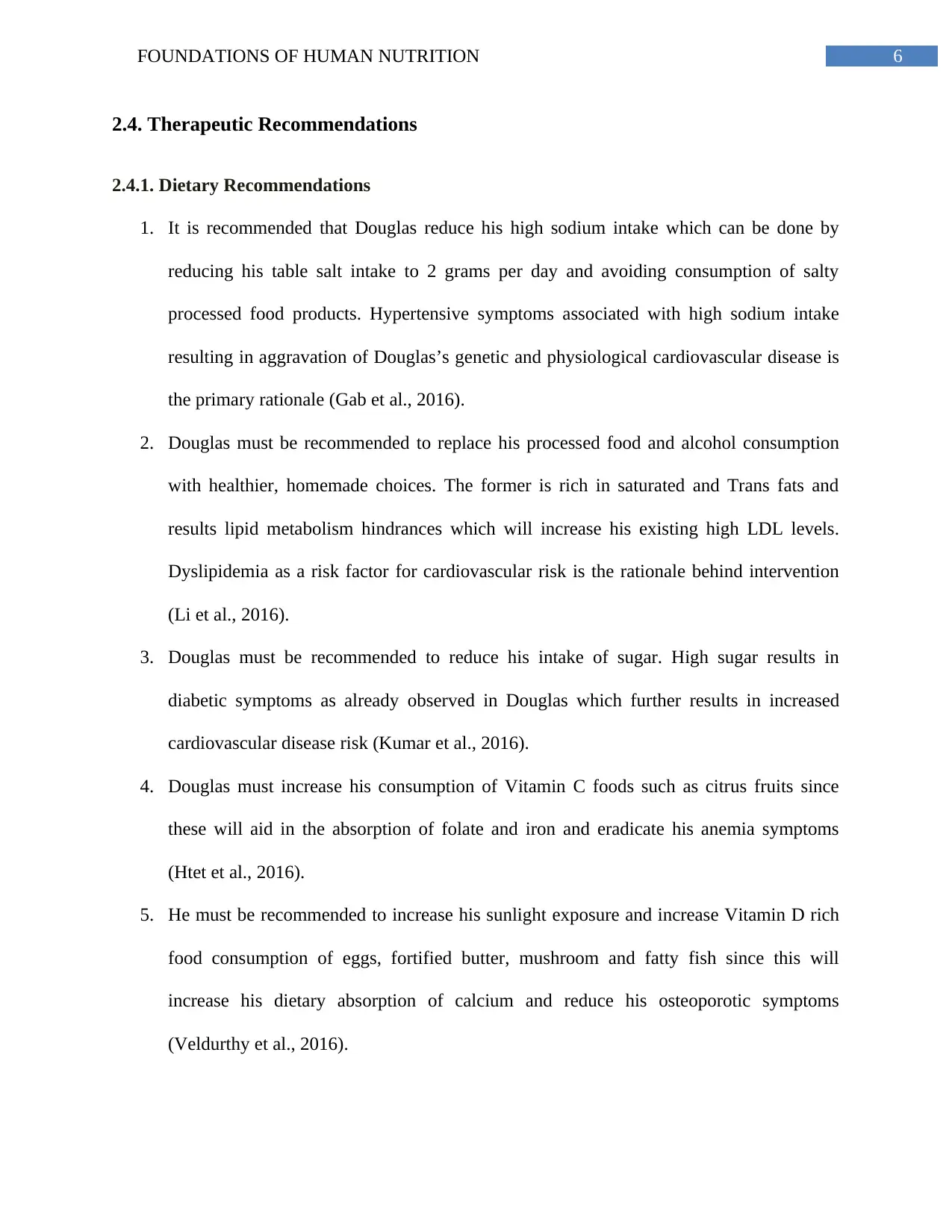
6FOUNDATIONS OF HUMAN NUTRITION
2.4. Therapeutic Recommendations
2.4.1. Dietary Recommendations
1. It is recommended that Douglas reduce his high sodium intake which can be done by
reducing his table salt intake to 2 grams per day and avoiding consumption of salty
processed food products. Hypertensive symptoms associated with high sodium intake
resulting in aggravation of Douglas’s genetic and physiological cardiovascular disease is
the primary rationale (Gab et al., 2016).
2. Douglas must be recommended to replace his processed food and alcohol consumption
with healthier, homemade choices. The former is rich in saturated and Trans fats and
results lipid metabolism hindrances which will increase his existing high LDL levels.
Dyslipidemia as a risk factor for cardiovascular risk is the rationale behind intervention
(Li et al., 2016).
3. Douglas must be recommended to reduce his intake of sugar. High sugar results in
diabetic symptoms as already observed in Douglas which further results in increased
cardiovascular disease risk (Kumar et al., 2016).
4. Douglas must increase his consumption of Vitamin C foods such as citrus fruits since
these will aid in the absorption of folate and iron and eradicate his anemia symptoms
(Htet et al., 2016).
5. He must be recommended to increase his sunlight exposure and increase Vitamin D rich
food consumption of eggs, fortified butter, mushroom and fatty fish since this will
increase his dietary absorption of calcium and reduce his osteoporotic symptoms
(Veldurthy et al., 2016).
2.4. Therapeutic Recommendations
2.4.1. Dietary Recommendations
1. It is recommended that Douglas reduce his high sodium intake which can be done by
reducing his table salt intake to 2 grams per day and avoiding consumption of salty
processed food products. Hypertensive symptoms associated with high sodium intake
resulting in aggravation of Douglas’s genetic and physiological cardiovascular disease is
the primary rationale (Gab et al., 2016).
2. Douglas must be recommended to replace his processed food and alcohol consumption
with healthier, homemade choices. The former is rich in saturated and Trans fats and
results lipid metabolism hindrances which will increase his existing high LDL levels.
Dyslipidemia as a risk factor for cardiovascular risk is the rationale behind intervention
(Li et al., 2016).
3. Douglas must be recommended to reduce his intake of sugar. High sugar results in
diabetic symptoms as already observed in Douglas which further results in increased
cardiovascular disease risk (Kumar et al., 2016).
4. Douglas must increase his consumption of Vitamin C foods such as citrus fruits since
these will aid in the absorption of folate and iron and eradicate his anemia symptoms
(Htet et al., 2016).
5. He must be recommended to increase his sunlight exposure and increase Vitamin D rich
food consumption of eggs, fortified butter, mushroom and fatty fish since this will
increase his dietary absorption of calcium and reduce his osteoporotic symptoms
(Veldurthy et al., 2016).
Paraphrase This Document
Need a fresh take? Get an instant paraphrase of this document with our AI Paraphraser

7FOUNDATIONS OF HUMAN NUTRITION
6. According to the Australian Dietary Guidelines, individuals must consume a balanced
diet rich in core food groups of grain, dairy, legumes, lean meats, fruits and vegetables
and unsaturated oils which will prevent deficiencies and result in positive life outcomes.
Following this rationale Douglas must be recommended to consume a balanced diet
adequate in all foods (Malek et al., 2016).
2.4.2. Nutrient Corrections
1. Douglas must correct his calcium deficiencies by consuming low fat dairy, green leafy
vegetables, nuts and seeds to prevent his risk of osteoporosis (Rosen et al., 2017).
2. Douglas must increase his intake of foods rich in Vitamin B9 and B12 which include
green leafy vegetables, legumes, beets, eggs, broccoli, Brussels sprouts, milk products
and lean meats. This will correct his deficiencies and alleviate his symptoms of anemia as
observed in the case study (Paul & Selhub, 2017).
3. Douglas must increase his consumption of dietary fiber rich foods such as whole grains,
green leafy vegetable and whole fruits since this will improve his constipation and future
risk of colon cancer and cardiovascular disease risk (Song et al., 2018).
4. Douglas must improve his protein intake my consuming vegetarian and lean protein
sources since this will increase his satiety, improve his insulin sensitivity and aid in
improving his lean body mass, metabolic rate and tissue repair due to obesity induced
oxidative stress (Crujeiras et al., 2016).
2.4.3. Lifestyle Recommendations
1. It is recommended that Douglas modify his physical activity by incorporating mild
resistance training which will reduce his knee pain and improve bone strength. This
6. According to the Australian Dietary Guidelines, individuals must consume a balanced
diet rich in core food groups of grain, dairy, legumes, lean meats, fruits and vegetables
and unsaturated oils which will prevent deficiencies and result in positive life outcomes.
Following this rationale Douglas must be recommended to consume a balanced diet
adequate in all foods (Malek et al., 2016).
2.4.2. Nutrient Corrections
1. Douglas must correct his calcium deficiencies by consuming low fat dairy, green leafy
vegetables, nuts and seeds to prevent his risk of osteoporosis (Rosen et al., 2017).
2. Douglas must increase his intake of foods rich in Vitamin B9 and B12 which include
green leafy vegetables, legumes, beets, eggs, broccoli, Brussels sprouts, milk products
and lean meats. This will correct his deficiencies and alleviate his symptoms of anemia as
observed in the case study (Paul & Selhub, 2017).
3. Douglas must increase his consumption of dietary fiber rich foods such as whole grains,
green leafy vegetable and whole fruits since this will improve his constipation and future
risk of colon cancer and cardiovascular disease risk (Song et al., 2018).
4. Douglas must improve his protein intake my consuming vegetarian and lean protein
sources since this will increase his satiety, improve his insulin sensitivity and aid in
improving his lean body mass, metabolic rate and tissue repair due to obesity induced
oxidative stress (Crujeiras et al., 2016).
2.4.3. Lifestyle Recommendations
1. It is recommended that Douglas modify his physical activity by incorporating mild
resistance training which will reduce his knee pain and improve bone strength. This
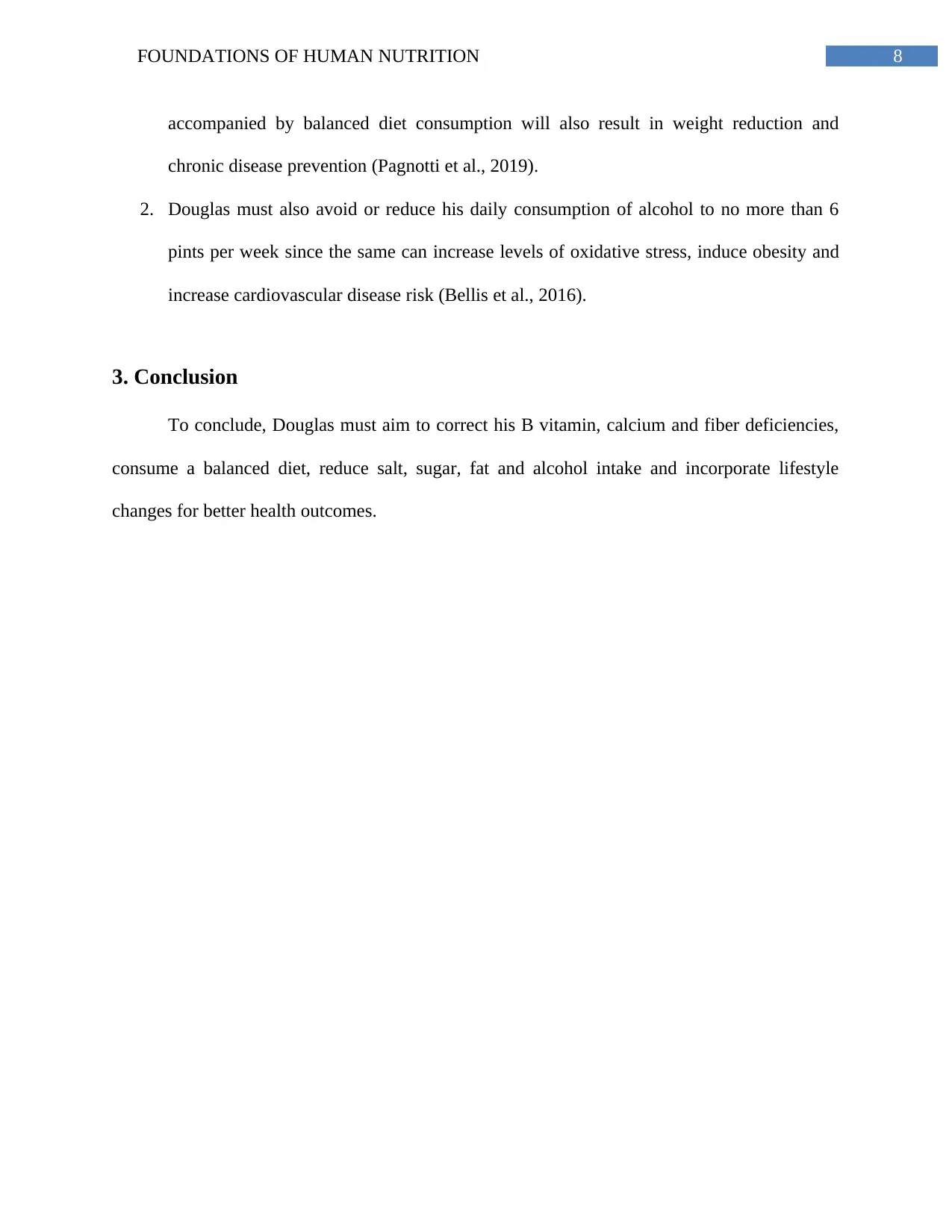
8FOUNDATIONS OF HUMAN NUTRITION
accompanied by balanced diet consumption will also result in weight reduction and
chronic disease prevention (Pagnotti et al., 2019).
2. Douglas must also avoid or reduce his daily consumption of alcohol to no more than 6
pints per week since the same can increase levels of oxidative stress, induce obesity and
increase cardiovascular disease risk (Bellis et al., 2016).
3. Conclusion
To conclude, Douglas must aim to correct his B vitamin, calcium and fiber deficiencies,
consume a balanced diet, reduce salt, sugar, fat and alcohol intake and incorporate lifestyle
changes for better health outcomes.
accompanied by balanced diet consumption will also result in weight reduction and
chronic disease prevention (Pagnotti et al., 2019).
2. Douglas must also avoid or reduce his daily consumption of alcohol to no more than 6
pints per week since the same can increase levels of oxidative stress, induce obesity and
increase cardiovascular disease risk (Bellis et al., 2016).
3. Conclusion
To conclude, Douglas must aim to correct his B vitamin, calcium and fiber deficiencies,
consume a balanced diet, reduce salt, sugar, fat and alcohol intake and incorporate lifestyle
changes for better health outcomes.
⊘ This is a preview!⊘
Do you want full access?
Subscribe today to unlock all pages.

Trusted by 1+ million students worldwide
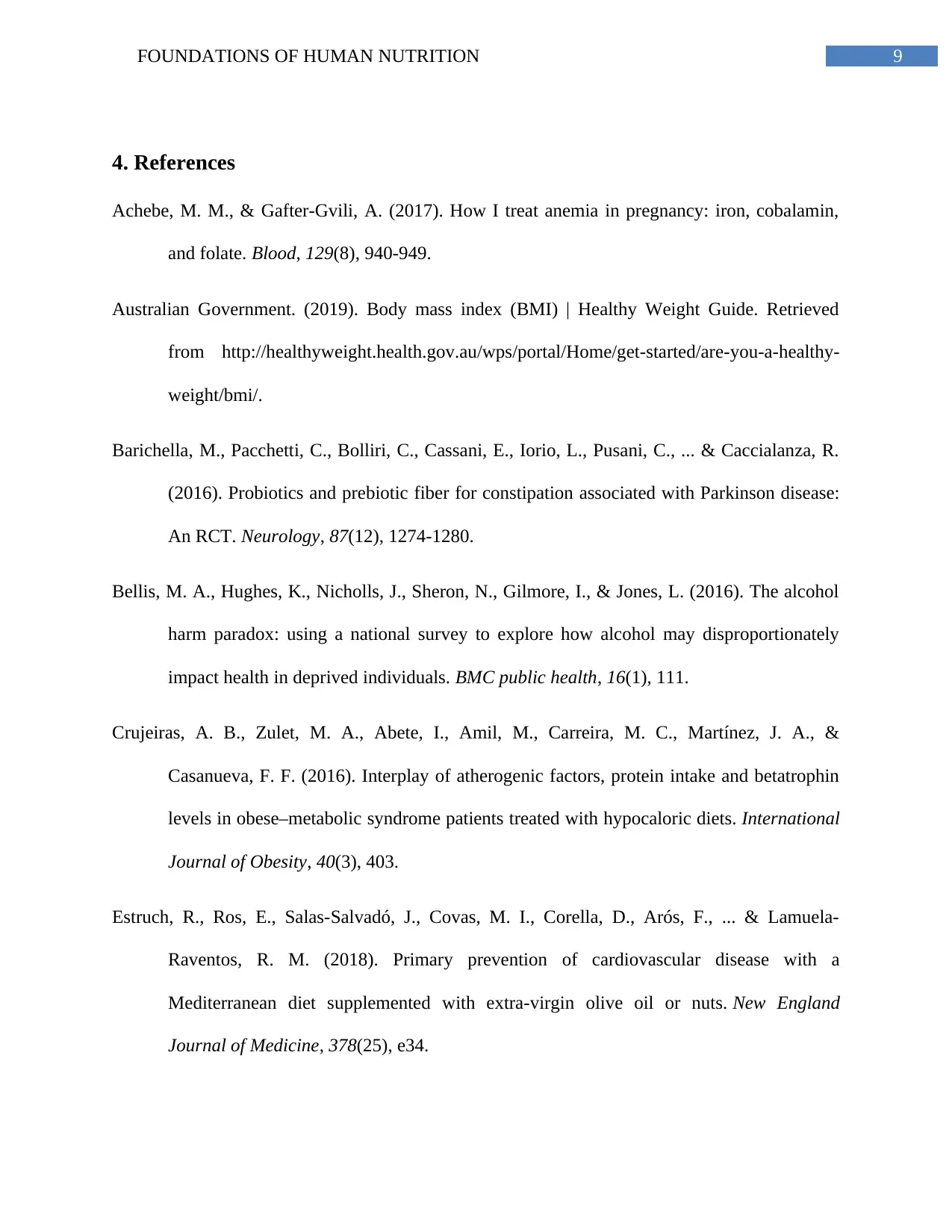
9FOUNDATIONS OF HUMAN NUTRITION
4. References
Achebe, M. M., & Gafter-Gvili, A. (2017). How I treat anemia in pregnancy: iron, cobalamin,
and folate. Blood, 129(8), 940-949.
Australian Government. (2019). Body mass index (BMI) | Healthy Weight Guide. Retrieved
from http://healthyweight.health.gov.au/wps/portal/Home/get-started/are-you-a-healthy-
weight/bmi/.
Barichella, M., Pacchetti, C., Bolliri, C., Cassani, E., Iorio, L., Pusani, C., ... & Caccialanza, R.
(2016). Probiotics and prebiotic fiber for constipation associated with Parkinson disease:
An RCT. Neurology, 87(12), 1274-1280.
Bellis, M. A., Hughes, K., Nicholls, J., Sheron, N., Gilmore, I., & Jones, L. (2016). The alcohol
harm paradox: using a national survey to explore how alcohol may disproportionately
impact health in deprived individuals. BMC public health, 16(1), 111.
Crujeiras, A. B., Zulet, M. A., Abete, I., Amil, M., Carreira, M. C., Martínez, J. A., &
Casanueva, F. F. (2016). Interplay of atherogenic factors, protein intake and betatrophin
levels in obese–metabolic syndrome patients treated with hypocaloric diets. International
Journal of Obesity, 40(3), 403.
Estruch, R., Ros, E., Salas-Salvadó, J., Covas, M. I., Corella, D., Arós, F., ... & Lamuela-
Raventos, R. M. (2018). Primary prevention of cardiovascular disease with a
Mediterranean diet supplemented with extra-virgin olive oil or nuts. New England
Journal of Medicine, 378(25), e34.
4. References
Achebe, M. M., & Gafter-Gvili, A. (2017). How I treat anemia in pregnancy: iron, cobalamin,
and folate. Blood, 129(8), 940-949.
Australian Government. (2019). Body mass index (BMI) | Healthy Weight Guide. Retrieved
from http://healthyweight.health.gov.au/wps/portal/Home/get-started/are-you-a-healthy-
weight/bmi/.
Barichella, M., Pacchetti, C., Bolliri, C., Cassani, E., Iorio, L., Pusani, C., ... & Caccialanza, R.
(2016). Probiotics and prebiotic fiber for constipation associated with Parkinson disease:
An RCT. Neurology, 87(12), 1274-1280.
Bellis, M. A., Hughes, K., Nicholls, J., Sheron, N., Gilmore, I., & Jones, L. (2016). The alcohol
harm paradox: using a national survey to explore how alcohol may disproportionately
impact health in deprived individuals. BMC public health, 16(1), 111.
Crujeiras, A. B., Zulet, M. A., Abete, I., Amil, M., Carreira, M. C., Martínez, J. A., &
Casanueva, F. F. (2016). Interplay of atherogenic factors, protein intake and betatrophin
levels in obese–metabolic syndrome patients treated with hypocaloric diets. International
Journal of Obesity, 40(3), 403.
Estruch, R., Ros, E., Salas-Salvadó, J., Covas, M. I., Corella, D., Arós, F., ... & Lamuela-
Raventos, R. M. (2018). Primary prevention of cardiovascular disease with a
Mediterranean diet supplemented with extra-virgin olive oil or nuts. New England
Journal of Medicine, 378(25), e34.
Paraphrase This Document
Need a fresh take? Get an instant paraphrase of this document with our AI Paraphraser
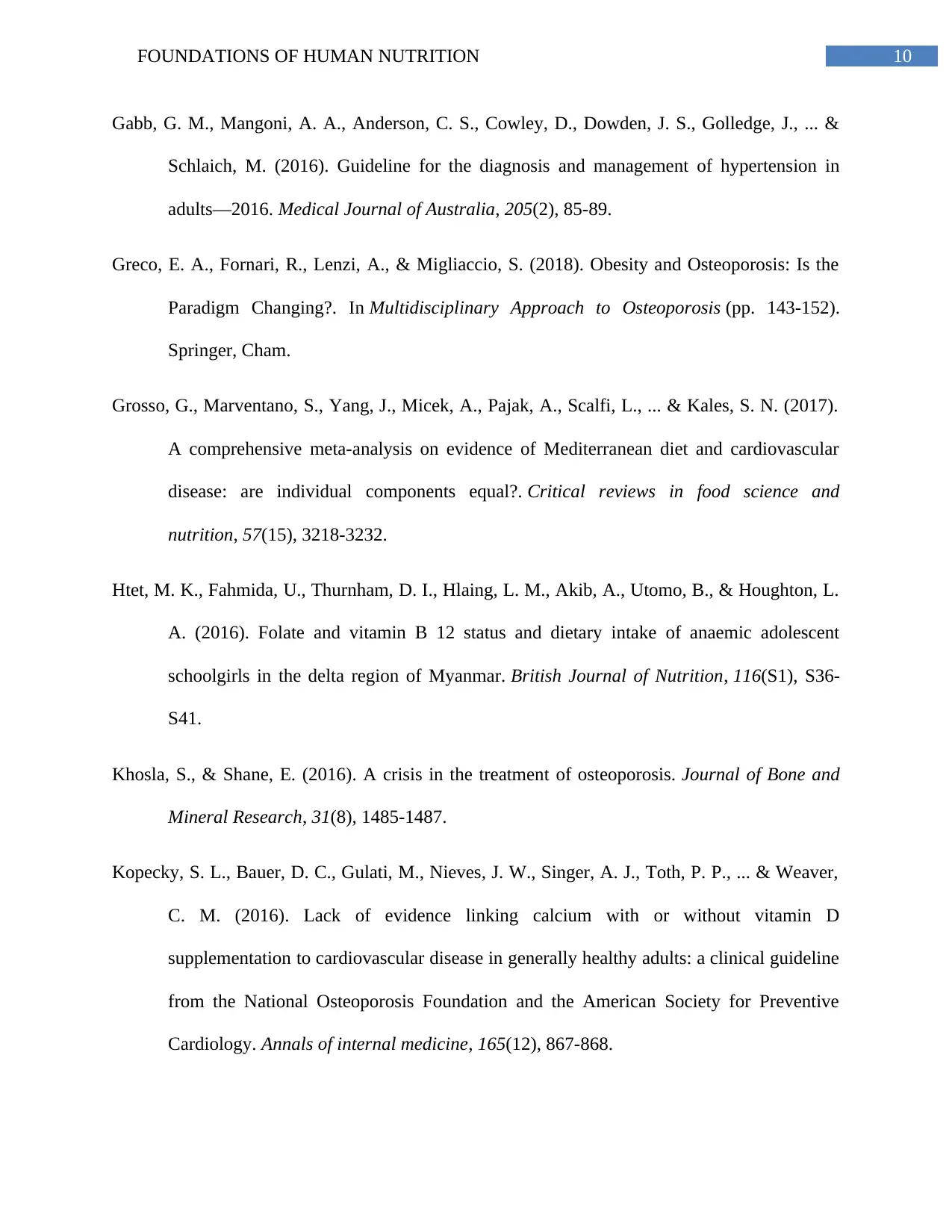
10FOUNDATIONS OF HUMAN NUTRITION
Gabb, G. M., Mangoni, A. A., Anderson, C. S., Cowley, D., Dowden, J. S., Golledge, J., ... &
Schlaich, M. (2016). Guideline for the diagnosis and management of hypertension in
adults—2016. Medical Journal of Australia, 205(2), 85-89.
Greco, E. A., Fornari, R., Lenzi, A., & Migliaccio, S. (2018). Obesity and Osteoporosis: Is the
Paradigm Changing?. In Multidisciplinary Approach to Osteoporosis (pp. 143-152).
Springer, Cham.
Grosso, G., Marventano, S., Yang, J., Micek, A., Pajak, A., Scalfi, L., ... & Kales, S. N. (2017).
A comprehensive meta-analysis on evidence of Mediterranean diet and cardiovascular
disease: are individual components equal?. Critical reviews in food science and
nutrition, 57(15), 3218-3232.
Htet, M. K., Fahmida, U., Thurnham, D. I., Hlaing, L. M., Akib, A., Utomo, B., & Houghton, L.
A. (2016). Folate and vitamin B 12 status and dietary intake of anaemic adolescent
schoolgirls in the delta region of Myanmar. British Journal of Nutrition, 116(S1), S36-
S41.
Khosla, S., & Shane, E. (2016). A crisis in the treatment of osteoporosis. Journal of Bone and
Mineral Research, 31(8), 1485-1487.
Kopecky, S. L., Bauer, D. C., Gulati, M., Nieves, J. W., Singer, A. J., Toth, P. P., ... & Weaver,
C. M. (2016). Lack of evidence linking calcium with or without vitamin D
supplementation to cardiovascular disease in generally healthy adults: a clinical guideline
from the National Osteoporosis Foundation and the American Society for Preventive
Cardiology. Annals of internal medicine, 165(12), 867-868.
Gabb, G. M., Mangoni, A. A., Anderson, C. S., Cowley, D., Dowden, J. S., Golledge, J., ... &
Schlaich, M. (2016). Guideline for the diagnosis and management of hypertension in
adults—2016. Medical Journal of Australia, 205(2), 85-89.
Greco, E. A., Fornari, R., Lenzi, A., & Migliaccio, S. (2018). Obesity and Osteoporosis: Is the
Paradigm Changing?. In Multidisciplinary Approach to Osteoporosis (pp. 143-152).
Springer, Cham.
Grosso, G., Marventano, S., Yang, J., Micek, A., Pajak, A., Scalfi, L., ... & Kales, S. N. (2017).
A comprehensive meta-analysis on evidence of Mediterranean diet and cardiovascular
disease: are individual components equal?. Critical reviews in food science and
nutrition, 57(15), 3218-3232.
Htet, M. K., Fahmida, U., Thurnham, D. I., Hlaing, L. M., Akib, A., Utomo, B., & Houghton, L.
A. (2016). Folate and vitamin B 12 status and dietary intake of anaemic adolescent
schoolgirls in the delta region of Myanmar. British Journal of Nutrition, 116(S1), S36-
S41.
Khosla, S., & Shane, E. (2016). A crisis in the treatment of osteoporosis. Journal of Bone and
Mineral Research, 31(8), 1485-1487.
Kopecky, S. L., Bauer, D. C., Gulati, M., Nieves, J. W., Singer, A. J., Toth, P. P., ... & Weaver,
C. M. (2016). Lack of evidence linking calcium with or without vitamin D
supplementation to cardiovascular disease in generally healthy adults: a clinical guideline
from the National Osteoporosis Foundation and the American Society for Preventive
Cardiology. Annals of internal medicine, 165(12), 867-868.
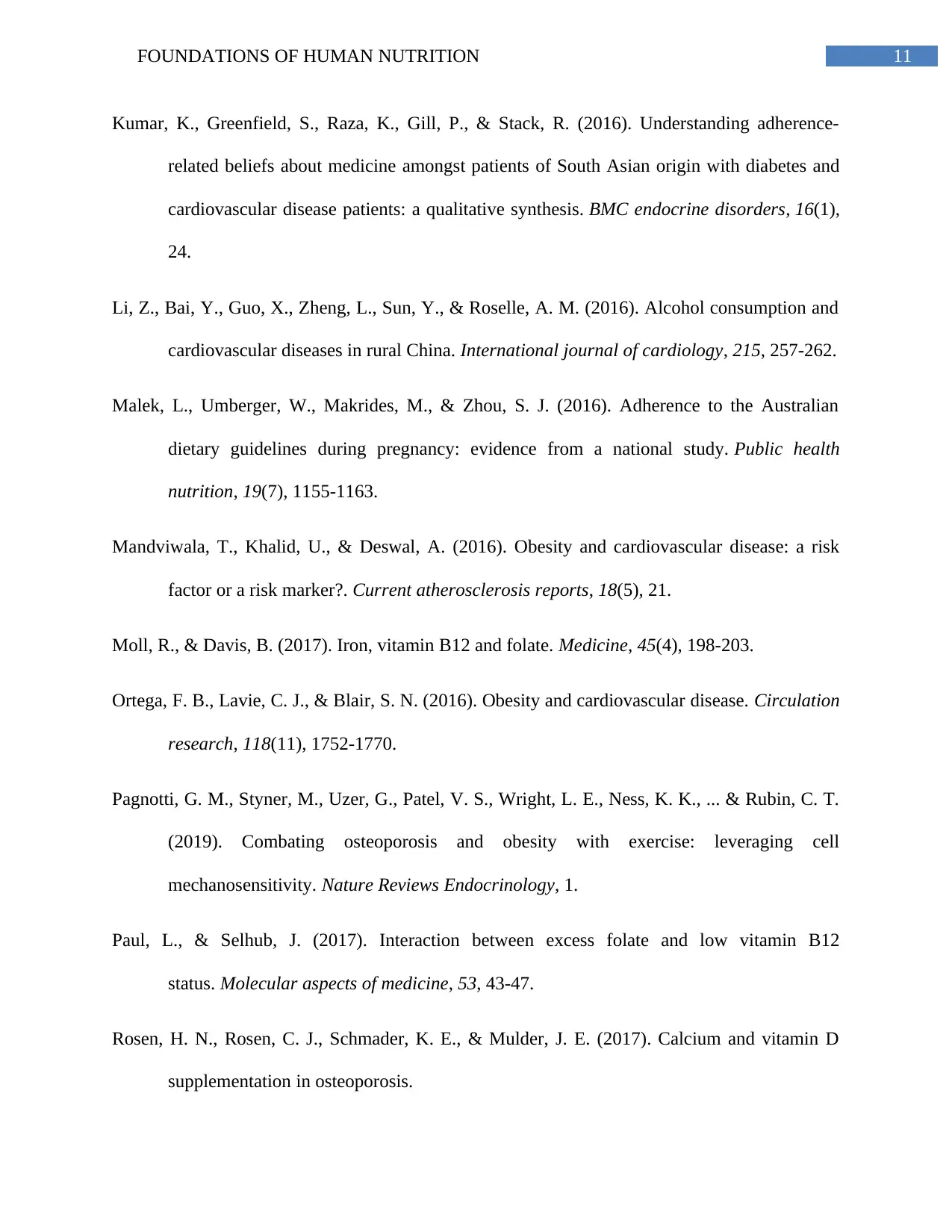
11FOUNDATIONS OF HUMAN NUTRITION
Kumar, K., Greenfield, S., Raza, K., Gill, P., & Stack, R. (2016). Understanding adherence-
related beliefs about medicine amongst patients of South Asian origin with diabetes and
cardiovascular disease patients: a qualitative synthesis. BMC endocrine disorders, 16(1),
24.
Li, Z., Bai, Y., Guo, X., Zheng, L., Sun, Y., & Roselle, A. M. (2016). Alcohol consumption and
cardiovascular diseases in rural China. International journal of cardiology, 215, 257-262.
Malek, L., Umberger, W., Makrides, M., & Zhou, S. J. (2016). Adherence to the Australian
dietary guidelines during pregnancy: evidence from a national study. Public health
nutrition, 19(7), 1155-1163.
Mandviwala, T., Khalid, U., & Deswal, A. (2016). Obesity and cardiovascular disease: a risk
factor or a risk marker?. Current atherosclerosis reports, 18(5), 21.
Moll, R., & Davis, B. (2017). Iron, vitamin B12 and folate. Medicine, 45(4), 198-203.
Ortega, F. B., Lavie, C. J., & Blair, S. N. (2016). Obesity and cardiovascular disease. Circulation
research, 118(11), 1752-1770.
Pagnotti, G. M., Styner, M., Uzer, G., Patel, V. S., Wright, L. E., Ness, K. K., ... & Rubin, C. T.
(2019). Combating osteoporosis and obesity with exercise: leveraging cell
mechanosensitivity. Nature Reviews Endocrinology, 1.
Paul, L., & Selhub, J. (2017). Interaction between excess folate and low vitamin B12
status. Molecular aspects of medicine, 53, 43-47.
Rosen, H. N., Rosen, C. J., Schmader, K. E., & Mulder, J. E. (2017). Calcium and vitamin D
supplementation in osteoporosis.
Kumar, K., Greenfield, S., Raza, K., Gill, P., & Stack, R. (2016). Understanding adherence-
related beliefs about medicine amongst patients of South Asian origin with diabetes and
cardiovascular disease patients: a qualitative synthesis. BMC endocrine disorders, 16(1),
24.
Li, Z., Bai, Y., Guo, X., Zheng, L., Sun, Y., & Roselle, A. M. (2016). Alcohol consumption and
cardiovascular diseases in rural China. International journal of cardiology, 215, 257-262.
Malek, L., Umberger, W., Makrides, M., & Zhou, S. J. (2016). Adherence to the Australian
dietary guidelines during pregnancy: evidence from a national study. Public health
nutrition, 19(7), 1155-1163.
Mandviwala, T., Khalid, U., & Deswal, A. (2016). Obesity and cardiovascular disease: a risk
factor or a risk marker?. Current atherosclerosis reports, 18(5), 21.
Moll, R., & Davis, B. (2017). Iron, vitamin B12 and folate. Medicine, 45(4), 198-203.
Ortega, F. B., Lavie, C. J., & Blair, S. N. (2016). Obesity and cardiovascular disease. Circulation
research, 118(11), 1752-1770.
Pagnotti, G. M., Styner, M., Uzer, G., Patel, V. S., Wright, L. E., Ness, K. K., ... & Rubin, C. T.
(2019). Combating osteoporosis and obesity with exercise: leveraging cell
mechanosensitivity. Nature Reviews Endocrinology, 1.
Paul, L., & Selhub, J. (2017). Interaction between excess folate and low vitamin B12
status. Molecular aspects of medicine, 53, 43-47.
Rosen, H. N., Rosen, C. J., Schmader, K. E., & Mulder, J. E. (2017). Calcium and vitamin D
supplementation in osteoporosis.
⊘ This is a preview!⊘
Do you want full access?
Subscribe today to unlock all pages.

Trusted by 1+ million students worldwide
1 out of 28
Related Documents
Your All-in-One AI-Powered Toolkit for Academic Success.
+13062052269
info@desklib.com
Available 24*7 on WhatsApp / Email
![[object Object]](/_next/static/media/star-bottom.7253800d.svg)
Unlock your academic potential
Copyright © 2020–2025 A2Z Services. All Rights Reserved. Developed and managed by ZUCOL.



